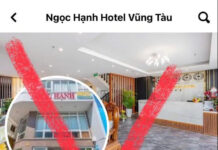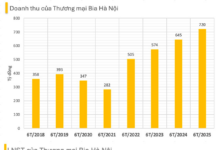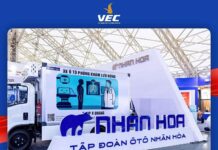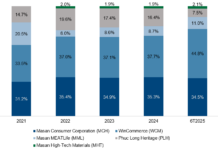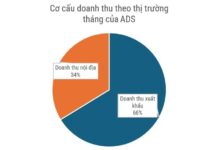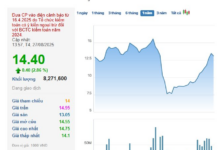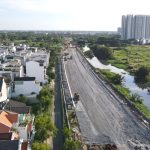The Ho Chi Minh City Department of Transportation has proposed the development of an automated guideway transit (AGT) line, an elevated train with self-driving capabilities, connecting Tan Son Nhat International Airport to the city center and Dam Sen Cultural Park.
Thach Ban Joint Stock Park Company has requested the city to consider including this elevated railway in its master plan to provide a basis for implementation.

The proposed elevated train line will be built entirely over canals and waterways, eliminating land clearance issues. Illustration created by AI Chat GPT
With a total length of nearly 30 kilometers and an estimated investment of VND 20,000 billion for the entire project, the project aims to alleviate long-standing traffic congestion around Tan Son Nhat International Airport.
In terms of timeline, Thach Ban Joint Stock Park Company has proposed a three-phase investment plan. Phase 1 involves the construction of a 12.7-kilometer section from Tan Son Nhat Airport in Tan Binh District to Cu Lao Nguyen Kieu in District 4, following the Nhieu Loc Thi Nghe canal.
For Phase 2, the company will develop a 5.7-kilometer section from Cu Lao Nguyen Kieu to Ba Tang Bridge in District 8, running along Kenh Doi (Double Canal). The third phase will cover a distance of 11.5 kilometers from Ba Tang Bridge to the intersection of Hoang Van Thu and Ut Tich streets, utilizing the Tan Hoa canal and Lac Long Quan street.
Are elevated self-driving trains more advantageous than monorails?
According to Thach Ban Joint Stock Park Company, the AGT line offers superior advantages over monorails (single-rail trains) due to the self-driving trains’ ability to change lanes flexibly, making it more convenient for route development, along with lower capital investment requirements. The main stations will be connected to the metro system.
The elevated self-driving train line utilizes a 4-meter-wide steel track, which can be mass-produced in factories, expediting project construction. With a completion time of approximately five years, the Mitsubishi-developed elevated automated guideway transit system was awarded the Good Design Award 2016 by the Japan Design Promotion Institute (JDP).
Additionally, as the route is proposed to be built entirely over canals and waterways, land clearance issues are eliminated. The company believes that the traditional approach to metro development, which takes decades to complete, will only exacerbate the existing traffic congestion in the city center, especially around Tan Son Nhat International Airport.
Therefore, they have petitioned Ho Chi Minh City to include this elevated self-driving train line in the master plan to provide a basis for its implementation.

Ho Chi Minh City aims to complete 183 kilometers of metro lines by 2035. Image source: Ho Chi Minh City Department of Transportation
According to the metro scheme submitted by the Ho Chi Minh City People’s Committee to the Municipal People’s Council in late June, the city aims to complete approximately 183 kilometers of urban railways by 2035, or within the next 11 years. By 2045, the city plans to construct an additional 168.36 kilometers to realize seven urban railway lines (according to the Adjusted Planning Scheme for the Construction of Ho Chi Minh City by 2040, with a vision towards 2060), bringing the total length of urban railways to approximately 351.08 kilometers.
By 2060, the remaining urban railway lines as per the approved plan will be completed, extending the total length to approximately 510.02 kilometers.
The preliminary estimated investment capital for construction and operation, excluding interest expenses during the construction period and investment capital for Metro Line 1, is approximately VND 837,249 billion (equivalent to USD 34.92 billion) from now until 2035.
Currently, Ho Chi Minh City has eight metro lines and three ground-level light rail or monorail lines planned, totaling approximately 220 kilometers in length, with estimated investment capital of nearly USD 25 billion. Among these, Line 1 (Ben Thanh – Suoi Tien) has taken 17 years of approval and 12 years of construction and is now nearing completion. Line 2, the Ben Thanh – Tham Luong section with a total length of over 30 kilometers, has also faced multiple delays, and its completion is not expected until 2030. The remaining lines have not yet received investment.
Ho Chi Minh City is currently home to nearly 9 million people (as of 2023), leading the country in population and second only to Hanoi in terms of area (3,359.82 square kilometers). It is also Vietnam’s largest economic, financial, commercial, and service center.
According to assessments, the city’s population overload is causing significant pressure, with an average increase of 1 million people every five years. With a total area of 2,095 square kilometers, the city’s population density is estimated at 4,375 people per square kilometer, the highest in the country today.
Proposed Planning for Adding 2 New Cities in Ho Chi Minh City
According to Architect Ngô Viết Nam Sơn, Ho Chi Minh City should consider planning two cities within the city in the south and north.
Three Economic Growth Scenarios for Ho Chi Minh City in Q1 2024
At the socio-economic meeting reviewing the results of January and setting the goals for February 2024, held this morning (1/2), the Ho Chi Minh City Institute for Research and Development has presented three economic growth scenarios for the first quarter of Ho Chi Minh City.



